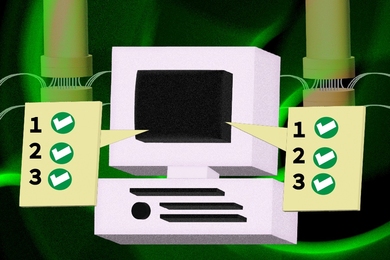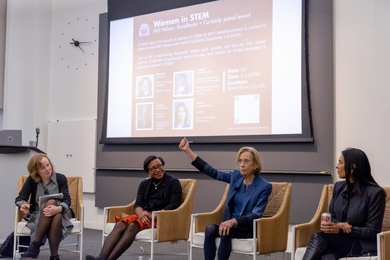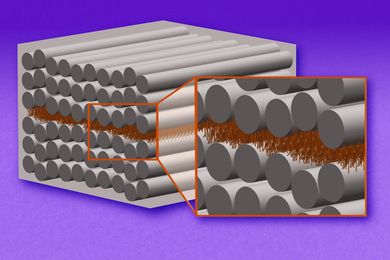An MIT scientist has found that a byproduct of the shellfish-processing industry could be recycled as an effective aid in sewage treatment.
Susan Murcott, a visiting research engineer in civil engineering, has shown that a compound derived from the shells of lobsters and shrimp can be used in a sewage-treatment process pioneered by her colleague Donald R. F. Harleman, Ford Professor of Engineering Emeritus.
In the Harleman process, known as chemically enhanced primary treatment (CEPT), small amounts of chemicals added to raw sewage cause particulates in the sewage to coagulate, or clump together and fall out of suspension. As a result, more particulates settle earlier than they would if simply left to settle by gravity-the conventional primary treatment currently used in most US sewage plants.
"And if you remove more material during primary treatment," explained Ms. Murcott, "you can decrease the size of the secondary treatment, which is extremely expensive." (In secondary treatment microbial organisms are used to digest organic matter.)
As a result CEPT, which is currently used in some plants in California, Canada, and Scandinavia, significantly reduces costs.
What Ms. Murcott has found is that chitosan, the compound derived from crustacean shells, can replace some or all of the chemical coagulants currently used in CEPT.
She is excited about these results for two reasons. First, chitosan is biodegradable, non-toxic, and non-petroleum based, which could make the compound attractive to current and prospective users of CEPT given new federal sludge regulations due out next month.
"Much of what you put into the treatment process ends up in the resulting sludge," Ms. Murcott explained. And since "the new regulations will set standards for what kinds of sludges can be used for what kinds of purposes," sewage plants will want to keep tabs on what's in their sludge. A biodegradable compound used in the treatment process means one less problematic compound in the resulting sludge.
Ms. Murcott is also excited about chitosan because the compound could be a boon for the fish-processing industry if CEPT gains widespread use. "I live by the sea and have friends who are fishermen," Ms. Murcott said. As a result, she is familiar with the industry and its current economic depression.
Right now, she said, large amounts of crustacean shells that are by-products of foods like lobster bisque are sent to landfills. If those shells were instead converted to chitosan, they could provide additional income for the industry (in addition to freeing up valuable landfill space).
In her research Ms. Murcott compared the effectiveness of chitosan as a replacement for each of the chemicals currently used together in CEPT. In general, these include a primary coagulant (a metal salt), a coagulant aid (a synthetic polymer), and sometimes a flocculant (another synthetic polymer that also causes particulates to clump together and fall out of solution).
She ran a variety of tests in which she replaced each chemical in turn with chitosan. Specifically, she looked at chitosan's effectiveness in removing two conventional pollutants (total suspended solids, or TSS, and biochemical oxygen demand, or BOD) from the sewage, then explored its effectiveness in removing metals and toxic organics (specifically, polycyclic aromatic hydrocarbons like napthalene, the primary ingredient in moth balls).
The tests on TSS and BOD removal were conducted at the Gloucester Water Pollution Control Facility; those on metals and toxic organics were conducted at Deer Island in Boston Harbor.
Ms. Murcott found that for TSS and BOD removal chitosan "showed promise as a primary coagulant [using a synthetic polymer as the coagulant aid] and as a coagulant aid [using a metal salt as the primary coagulant]." In both cases chitosan "performed comparably to or slightly less efficiently than the best results we've been able to obtain with conventional CEPT." (She notes, however, that when chitosan is overdosed it increases BOD.)
The results are reported in a paper written for MIT Sea Grant earlier this year by Ms. Murcott and Professor Harleman. (The work was funded by Sea Grant.)
This summer Ms. Murcott ran tests on chitosan's effectiveness in removing metals and polycyclic aromatic hydrocarbons (PAHs). The results for metals "showed that chitosan as the primary coagulant is more effective than metal salts in removing a variety of metals from the waste stream."
PAH results showed that chitosan is effective as a coagulant aid in removing PAHs, but tests on its effectiveness as a primary coagulant were inconclusive.
Over the summer Ms. Murcott also looked at the effectiveness of other natural materials for use in CEPT, including ground-up acorns, almonds, and seeds of several species of the tropical tree Moringa. Two species of Moringa worked well. Specifically, she found that "chitosan as the primary coagulant and Moringa as a coagulant aid were very efficient at removing TSS and BOD."
She notes, furthermore, that the chitosan/Moringa combination was effective in smaller doses than metal salt/synthetic polymer combinations. This is important because "the smaller the dose the smaller the quantity of sludge produced," Ms. Murcott said.
The effectiveness of Moringa seeds also has another benefit. "Their use as coagulants could help support tropical forestry practices that harvest products from tropical trees instead of cutting them down," Ms. Murcott said. Moringa species are very abundant in Africa and India.
The above results from Ms. Murcott's work over the summer are reported in a second paper completed this month for Sea Grant.
Ms. Murcott is currently beginning work on the effectiveness of chitosan and other natural compounds in treating drinking water (scientists in Europe have reported good results there).
The work could help Massachusetts municipalities like Cambridge, Reading and Weymouth that currently treat their water. It could also be of use to the Massachusetts Water Resources Authority, or MWRA, which will be building a large water-treatment facility at Wachusett Reservoir to treat drinking water for the Greater Boston area. (Ms. Murcott will conduct tests at the reservoir later this fall.)
Ms. Murcott explained that drinking-water treatment plants typically use the chemical alum in a coagulation process identical to that used in CEPT. As a result, she said, the sludge resulting from this process contains a great deal of alum. And in preparing for the new federal regulations described earlier, the MWRA will no longer allow plants to pump their alum-laden sludge into the MWRA system.
"The MWRA wants control over what's in their sludge, given the new regulations," Ms. Murcott said.
Since chitosan is biodegradable and non-toxic, if it is effective in drinking-water treatment it would be preferable over alum "and give these municipalities another option to consider," Ms. Murcott concluded.
A version of this article appeared in the October 28, 1992 issue of MIT Tech Talk (Volume 37, Number 11).





